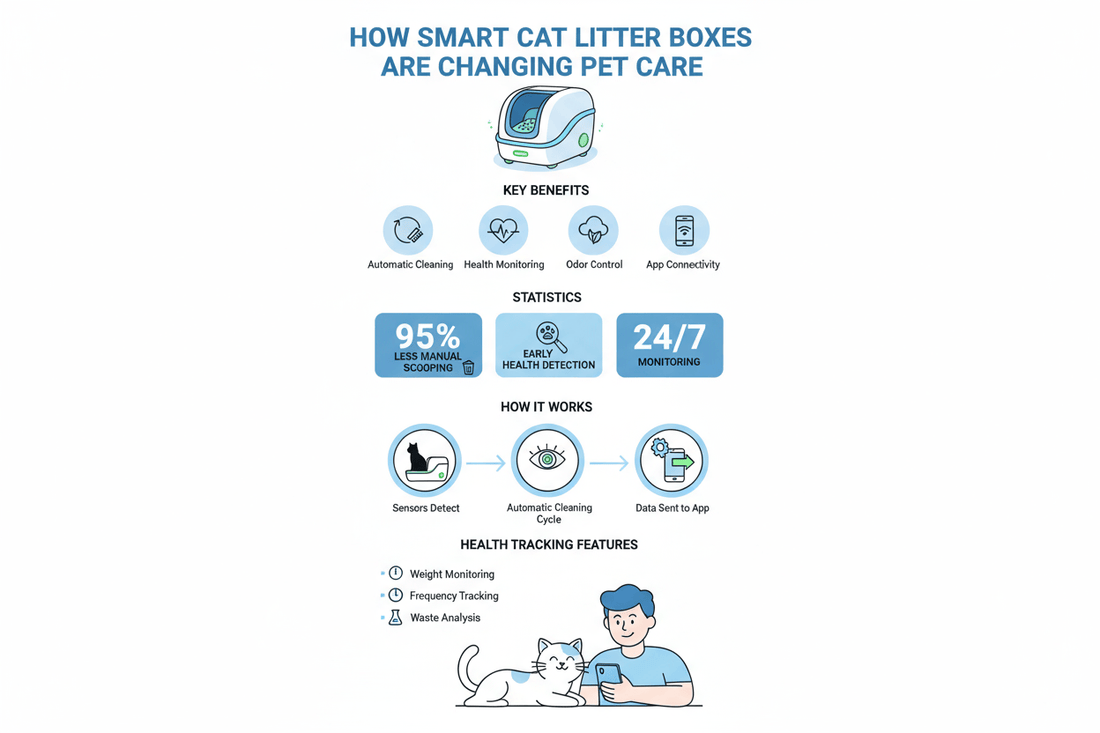
How Smart Cat Litter Boxes Are Changing Pet Care (2025): Inside the Famistar Revolution
Share
Q: What is a self-cleaning cat litter box and why are pet owners switching?
A: A self-cleaning cat litter box—often called a smart cat litter box—automates waste removal and odor control so you scoop less and monitor more.
Over the last decade, pet-care tech has moved beyond novelty into everyday life. For many households, the smart litter box is the single most practical upgrade: it reduces daily chores, keeps the environment cleaner for cats, and offers data that can help owners spot changes in bathroom habits. The Famistar litter box positions itself at this intersection—offering automated cleaning cycles, a sealed waste reservoir, and safety features designed for real homes. Recent studies on feline litter preferences emphasize hygiene as a key factor in reducing stress.
What smart litter boxes actually do—and why it matters
At its core, an automatic cleaning cat box combines sensors, timed mechanics, and waste containment to remove soiled litter soon after use.

According to Cornell Feline Health Center, consistently clean toileting areas reduce stress and help prevent litter-box avoidance, which is one common cause of elimination problems.
Key functions in plain terms
| Function | Benefit |
|---|---|
| Occupancy sensors | Delay cleaning until the cat leaves, protecting safety |
| Automated raking or rotation | Keeps clean litter separate—fewer scoops for you |
| Sealed waste compartment | Controls odor and reduces airborne particulates |
| App or logs (when available) | Shows usage trends that may flag health changes (AVMA multi-cat guidance) |
Health monitoring: subtle signals you might otherwise miss
Changes in urination frequency, duration, or posture can signal urinary tract disease. Veterinary education resources explain that early behavioral signs can precede clinical symptoms, so tracking litter-box use can be a practical way to notice unusual patterns. The CDC Healthy Pets guidelines also note that monitoring pet waste can provide clues to overall feline health.
Why Famistar is part of the “revolution”
Famistar’s design focuses on three buyer priorities: dependable cleaning mechanics, straightforward maintenance, and built-in safety. The result is an AI litter box-style experience that feels less like a gadget and more like a home improvement—cutting daily maintenance while fitting into a typical household routine. Consumer reviews aggregated by Consumer Reports highlight reliability and ease of use as top factors in adoption.
Real-life benefits for cat parents
- Fewer daily chores: Automated cycles mean you’re not scooping multiple times a day.
- Improved home odor control: Prompt waste containment lowers lingering smells (EPA Pet Waste Management).
- Happier cats: Cleaner boxes match feline preference for tidy toileting spaces.
- Better monitoring: Usage logs can help you spot sudden changes that warrant a vet visit (AVMA Behavioral Insights).
Potential drawbacks—and how to mitigate them
- Adaptation time: Introduce the new box slowly—keep the old box nearby and allow exploration before enabling cleaning cycles.
- Litter compatibility: Verify the brand’s recommended litter types to avoid mechanism jams.
- Maintenance & cost: Some ongoing costs (filters, bags) may apply; weigh these against the time saved scooping.
- Multiple cats: Large or multi-cat homes may still need multiple boxes for best behavior outcomes (AVMA multi-cat guidance).
Smart litter box buying checklist
- Confirm interior size and entry height match your cat’s dimensions.
- Look for clear safety interlocks and slow-start motors.
- Check waste drawer capacity and ease of emptying.
- Verify what litter types are supported and whether the model offers filters or sealed bags.
- Read owner reports on long-term reliability and noise level.
How to bring a smart box into your home
Behavioral experts recommend gradual introductions: place the new unit beside the current box, let your cat explore with the unit powered off, then enable automated cycles slowly once your cat shows comfortable use. This stepwise approach reduces stress and increases success (CDC Healthy Pets).
FAQs
How often should I empty a self-cleaning litter box?
It depends on the model’s waste capacity and how many cats use it. Many owners empty weekly rather than daily; follow the manufacturer’s guidance for hygiene and odor control.
Can a smart litter box replace regular vet checkups?
No—while usage data can alert owners to changes, these systems are monitoring tools, not diagnostic devices. Use logs to inform veterinary conversations when you notice an abrupt or sustained change.
Is disposal of sealed waste bags environmentally responsible?
Follow your local municipal rules for disposal. For best practices on managing pet waste and community health, refer to official guidance from the EPA.
Wrap-up
For many cat owners, the leap to a self cleaning cat litter box is the single most effective way to improve household hygiene and reduce daily chores. The Famistar litter box blends automation, safety and practical maintenance—making it a strong option for those ready to upgrade. When chosen and introduced thoughtfully, a smart solution can make life easier for you and more comfortable for your cat.

